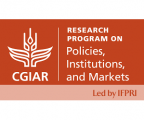Outline
- 01Summary
- 02Key Findings
- 03Reference Scenario
- 04Alternative Scenarios
- 05Funding Partners
Papers and Data
Who we are
This webtool was developed by Soonho Kim, Nicola Cenacchi, the IMPACT modeling team at IFPRI (Keith Wiebe, Tim Sulser and Shahnila Dunston) and the Food Security Portal team (Rob Vos, Betina Dimaranan, Brendan Rice, and Sara Gustafson). For any comments or feedback please contact Soonho Kim (soonho.kim@cgiar.org)
As the world deals with the impacts of the Covid-19 pandemic, the international community has started discussing more urgently how land use change and the conversion of natural habitats to agricultural or urban ecosystems can affect the risk and emergence of zoonotic diseases in humans as well as the spread of new pathogens and diseases in livestock.
African swine fever (ASF) is an infectious disease of pigs originating in Africa. It has recently spread to east Asia and, in 2018, it was observed for the first time in China. By the summer of 2020, China had experienced several outbreaks and, by some accounts, the country lost 180 million pigs or about 40% of total.
China is the world's largest producer of pig meat. It is therefore important to explore potential consequences of a major epidemic in China on pork production and consumption globally, not only for pork producers but also on feed markets, the demand for alternatives to pig meat, and how this may affect the diets and food security of consumers in areas directly and indirectly affected by the disease.
The scenarios presented in this tool explore different magnitudes of shocks to pork production due to the ASF epidemic based on production data around the year 2018.
Key Findings
China is still dealing with a devastating outbreak of African swine fever which started in 2018 and has strongly reduced pork production. Two linked global economic models were used to explore the impact that epidemics of this level of magnitude may have on the global pork market and the cascading effects on production and prices of other food types and animal feed and on global food security.
Global pork prices
Depending on the severity of the epidemic, the decline in production may cause an increase in global pork prices of between 17 and 85%.
Decrease in pork demand
The higher prices cause a decrease in pork demand across all regions, and they spur pork production in regions outside China, thereby reducing the impact on global pork production.
Secondary effect of higher pork prices
Secondary effects of higher pork prices include an increase in both demand and prices of other meats, such as beef and poultry, as well as a decrease in price of maize and soybean as their use for feed declines.
Decline in per-capita calorie availability in China
The sum of the effects leads to a decline in per-capita calorie availability in China. Effects in other regions are mixed, with some seeing an increase and others a decrease in calories.
Reference Scenario
China is the world's largest producer of pig meat. In 2018 it produced over 50 million metric tons of pork, from over 700 million slaughtered pigs. Demand for pig meat is projected to keep rising in China and especially across the developing world. In the reference scenario, production of pig meat in China is not affected by an ASF epidemic. Growth is determined by several factors, including assumptions for population and income, population preferences (represented through elasticities), and technological growth.
1. Pork markets in China and selected regions in 2018
Click here for the full screen
Source: Mason-D’Croz, D., Bogard, J.R., Herrero, M. et al. Modelling the global economic consequences of a major African swine fever outbreak in China. Nat Food 1, 221–228 (2020). https://doi.org/10.1038/s43016-020-0057-2
2. Markets of selected commodities in China and other regions
Click here for the full screen
Source: Mason-D’Croz, D., Bogard, J.R., Herrero, M. et al. Modelling the global economic consequences of a major African swine fever outbreak in China. Nat Food 1, 221–228 (2020). https://doi.org/10.1038/s43016-020-0057-2
3. Food security indicators
Click here for the full screen
Source: Mason-D’Croz, D., Bogard, J.R., Herrero, M. et al. Modelling the global economic consequences of a major African swine fever outbreak in China. Nat Food 1, 221–228 (2020). https://doi.org/10.1038/s43016-020-0057-2
Map disclaimer: The boundaries and names shown and the designations used on this map do not imply official endorsement or acceptance by the International Food Policy Research Institute. (IFPRI).
Alternative Scenarios
We explored potential impacts with five alternative scenarios using different assumptions for severity of ASF effects in 2018. In the 5 scenarios pig production in China remained constant (S0, no ASF outbreak) or was reduced by 20, 40, 60 or 80% due to the virus (the scenarios are respectively labeled S20, S40, S60 and S80).
All the figures below show the effects of the four outbreak scenarios compared to the reference scenario S0.
1. Effects on pork prices, demand, and production
Click here for the full screen
Source: Mason-D’Croz, D., Bogard, J.R., Herrero, M. et al. Modelling the global economic consequences of a major African swine fever outbreak in China. Nat Food 1, 221–228 (2020). https://doi.org/10.1038/s43016-020-0057-2
2. Effects on other commodities
Click here for the full screen
Source: Mason-D’Croz, D., Bogard, J.R., Herrero, M. et al. Modelling the global economic consequences of a major African swine fever outbreak in China. Nat Food 1, 221–228 (2020). https://doi.org/10.1038/s43016-020-0057-2
3. Effects on food security
Click here for the full screen
Source: Mason-D’Croz, D., Bogard, J.R., Herrero, M. et al. Modelling the global economic consequences of a major African swine fever outbreak in China. Nat Food 1, 221–228 (2020). https://doi.org/10.1038/s43016-020-0057-2
Map disclaimer: The boundaries and names shown and the designations used on this map do not imply official endorsement or acceptance by the International Food Policy Research Institute. (IFPRI).
Funding Partners
We gratefully acknowledge our partners for their funding in support of the Tool pages within the Food Security Portal.

The CGIAR Research Program on Policies, Institutions, and Markets (PIM)
